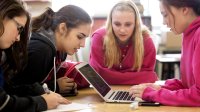6 Strategies for Promoting Student Autonomy
These techniques foster independence and show students how to help themselves—and their peers—understand and complete tasks.
Your content has been saved!
Go to My Saved Content.Flexible classrooms rely on students exercising a certain degree of independence. If teachers want to maximize their time working with individuals and small groups, for example, they need the rest of the class to be self-sufficient.
Unfortunately, as teachers know too well, children of all ages often default to dependence on adult help. Instead of ridding the classroom of tasks that require autonomy, teachers can equip students with the skills and know-how to be their own best assistants.
Six Simple Strategies for Promoting Student Autonomy
1-2-3 Then Me: This approach asks students to rely first on their own and their peers’ understanding of a task. Give students one minute to go over the directions silently, two minutes to discuss the directions with each other, and three minutes to plan their approach to the task. Only then can they ask for assistance. Or give a one-minute explanation of the directions to the whole class in place of or prior to students reading the directions silently or in pairs.
Recorded Directions and Responses: These are simple but powerful tools, especially for students whose reading and writing skills are still developing. With the voice memo function on a device, record yourself giving directions. (You can use an accent or character voice, for fun.) Students play back the directions when needed, rewinding to listen to trouble spots or simply to hear your explanation again. Place the device at the station or center where students complete their tasks, or post the file on a class website or app like Seesaw. Alternatively, students can record themselves or a peer reading or explaining directions aloud for later playback.
Digital recordings build independence in task completion if students can also record their response to a task or their skill performance. This frees the student from having to wait for an audience and allows the teacher to work with individuals or small groups. With younger children, responses can be played back directly from the devices. Older students can upload their responses to a dedicated site or folder.
Resource Files: Another self-help mechanism when the teacher isn’t available. These files include troubleshooting tips for routines and tools that students use on a regular basis. For instance, what to do when the iPad screen freezes or how to push through writer’s block. Resource files can include extra graphic organizers, peer editing protocols, and rubrics. The files can be physical (i.e., folders with paper materials inside) and placed in a prominent area of the room, or digital files in a clearly marked, easy-to-access spot on a device.
Hint Cards: Similar to resource files, but lesson-specific. The teacher in this video, for example, has anticipated likely trouble spots with the mathematics tasks students are working on. Her hint cards ask probing questions that she would pose to students if they were stuck, and students use the cards before consulting her. Over time, students internalize both the questions and the process for getting unstuck.
Colored Cups: This self-monitoring and signaling strategy builds students’ skills in deciding if and when they need teacher help. Each group (or individual) receives a stack of three colored cups (ideally, green, yellow, and red to mimic traffic lights). The teacher instructs the student to display the cup that matches how they’re working:
- Green cup on top: I am/we are fine—no teacher help needed.
- Yellow cup on top: I/we need teacher help but can continue working while waiting for it.
- Red cup on top: I/we need teacher help immediately and have stopped working.
The teacher monitors the cups while circulating, and works with groups according to urgency. At first, teachers may find that students regard every stumbling block as a red-cup situation. This is another opportunity to encourage independence: Point out when the cup should be yellow and direct the student or group to what they can work on while waiting for you. Leave for a few minutes and return to assist if the top cup is yellow or red.
Question Chips: These help students decide whether their questions about tasks are “must ask the teacher” or “could find out myself.” Each student—or group—receives a limited number of question chips (e.g., pennies, paper squares, or game chips) for the class period or longer. These represent the number of times students can call on the teacher for help. If students have only a few chips, they’re less likely to raise their hands and summon the teacher for easy-to-answer questions.
The spirit of question chips is not to squelch inquiry or discourage students from seeking clarity—the idea to for them to ask themselves, “Is this something that I already know, will find out soon, or can ask a peer—or do I need to ask this now so that I understand?” As with the colored cups, teachers can be instructive as everyone learns how to use the chips. For example, if a student poses a procedural question, say “Do you really want to use a chip on that?” and make a general suggestion about when, where, or how to find the answer.
To be effective, these strategies must be taught and modeled. Introduce them as needed, and use those that suit your subject, students, and style. Students won’t become independent overnight, but in time and with practice, they can all learn how to help themselves.
